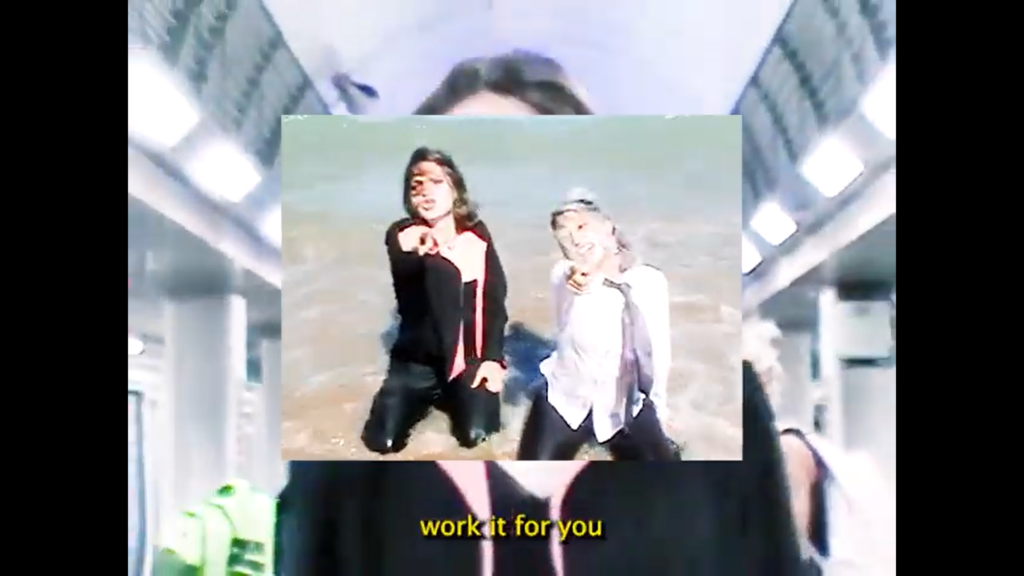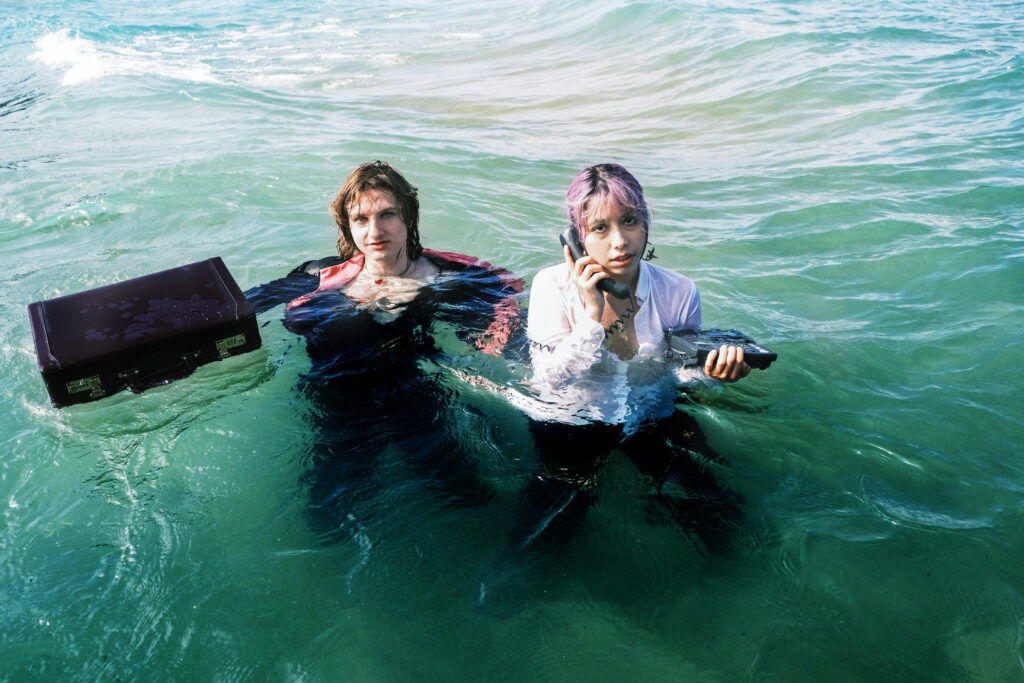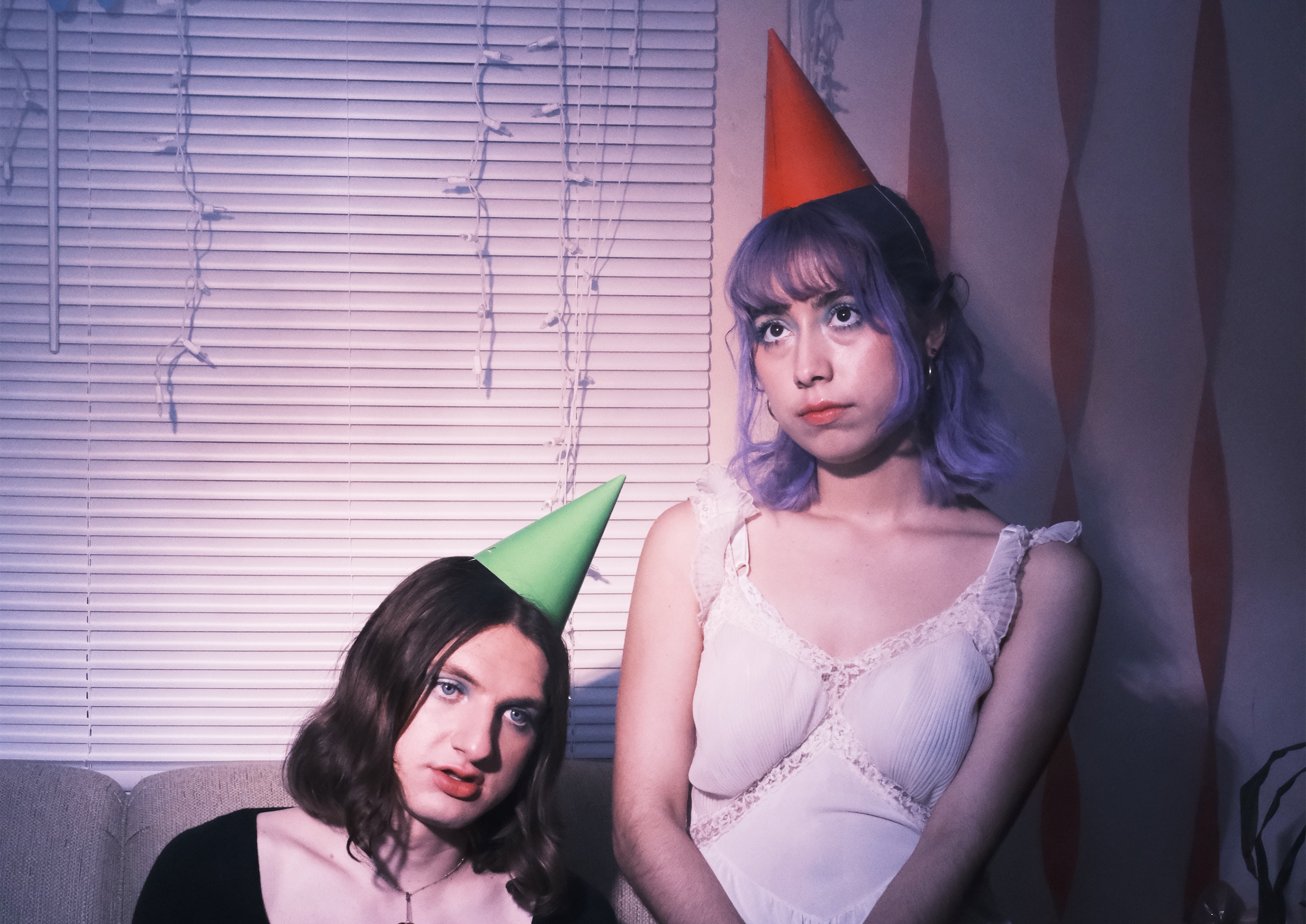When I heard Soft and Dumb’s fantastic self-titled album, I knew I wanted to hit them up for a Home Studio Stories interview. It’s a really gorgeous album filled with Midwest emo twinkles, shoegaze affectations, and math-y time signatures. Those are all things I’m a sucker for already, so I was already guaranteed to dig the release, but what really struck me as special about it was how honest and natural it felt.
The album feels “live” in a way that many expensive studio albums do not. There’s an immersion to it, as if you’re hearing them perform directly to you at a basement show. It’s a special sound that really only comes from the gritty self-production found within the DIY scene.
I chatted with band members Elena Buenrostro and Travis Newgren over Zoom about playing house shows in Urbana IL, shitty 2005 camcorders, and the joys of recording synths in a freezing cold closet.

First question – how would you describe your overall sound?
Elena: Rock is the term that applies to a lot of our music, but not all of it. It’s hard to pin our sound down. We’re attracted to weird time signatures, attracted to really pop melodies, and having shoegaze elements in our work. But I don’t think we would necessarily fit neatly into any of those genre lists.
Travis: Yeah, it’s also like, me and Laney both have pretty different musical tastes. Laney brings a lot of singer-songwriter style stuff to the table, you know – Soccer Mommy, Mitski, and those sorts of inspirations, and then I bring more of a math-y element. And, you know, since it’s just the two of us, it’s not like there’s a band leader and then a bunch of people there along for the ride. It’s kind of a conversation between the two of us.
A conversation, that’s interesting…what does a typical songwriting session look like then?
Elena: Typically, I come up with a guitar part. Maybe I’ll come up with a vocal melody or some lyrics. And then I’ll come down to the basement and show Travis. It won’t be a fully fleshed out song at all. We can compose it together and then jam and create new parts. And in that way it is a conversation, because I try to keep everything super flexible. He can influence me and I can influence him.
Travis: Our writing styles complement each other, too. Laney is super vocally gifted and talented. Me, it’s like – yeah I love vocals, I love the idea of them. But as an artist, I’m so connected to music on a harmonic, rhythmic level. I’d rather just hold down the fort on the rhythmic section and let Laney go for it.
The self-titled was all recorded together in your basement, right?
Elena: Yes.
Travis: There are two electronic songs, “moonshoes” and “work it,” that we recorded up in Laney’s walk-in closet like in Urbana. But all the analog stuff that you hear, we just mic’d up drums and guitar and did it live at the same time. That was a really, really important thing to us – recording and sounding live.
Elena: Yeah, I think since a lot of the songs we’d been playing live for so long, it was important to us to keep that sort of live feeling. For a long time we were strictly a live band. We were playing like… sometimes three shows a weekend, you know?
I’m glad that you brought up the live-ness of it all. I read your Smile Politely interview, and one of you said that you had made your earlier release, Out of Bed, before doing any live shows. Did playing live shows affect your approach to recording Soft and Dumb?
Elena: Oh 100%. Out of Bed was a project that we created during the pandemic lockdown in Travis’s apartment. We were going absolutely insane because of the lack of human connection. It was made entirely in front of a laptop.
Travis: It was like a Cabin Fever style project. We technically had played one live show before recording, but it was a week before lockdown started for the pandemic. So it was a little bit of a fake out. We were like, “Come on, we wanted to be a band, what is this all about?”
You’re very active in the DIY scene in Urbana. What’s that scene like?
Elena: So, it’s a college town. It’s filled with a bunch of young, very passionate people. There’s a bunch of house show venues there like Waluigi’s Mansion and The Spice Rack. It honestly feels like a playground for musicians, or for people who want to perform in general. It was really an important place for us to experiment, get our live show chops up, and get experience performing. The importance of DIY scenes like that is that it encourages people, it gives people the confidence to perform, which is a really difficult thing for certain people. It’s something I struggled with. I never thought I would ever perform in my life because I had intense performance anxiety. I hope that when people see us perform, they’re like, “oh, yeah, I can do that.” It’s my goal to tell every person I talk to who comes up to me after a show, “I’m trying to get you in a band, I need you to be in a band and I need you to perform.” And that’s the way the scene thrives.
Travis: It’s a diverse place with people coming from all over. I just think that Urbana, especially, is an inclusive place. You’ll see DJ shows, you’ll see a rap show mixed with a Midwest emo band. But yeah, Laney hit it on the head, just in terms of like a low barrier to entry. And just the general culture and attitude. It just feels like there’s some magic there in Urbana.
What made you want to include an actual live recording on the album? How did you set that up with the venue and everything?
Elena: Well, Sleeping Village, they just sort of allowed us to do that. Because they have this crazy mixing board and Travis was like, “can I record this?”
Travis: Yeah, they were just like, if you want to plug your laptop in the board, you can. As far as why we chose to include it… I never went into the show thinking like, “Yeah, this is going to make the cut” or anything like that. We had written “gasp” either during or a little after we recorded all the stuff for the album. So we really didn’t want to have to go down to the basement and record everything again. That – plus the fact that it sounded, in my opinion, awesome – was enough to be like, “I don’t think we could really do better if we tried.” The crazy thing is that it’s just guitar and drums and Laney’s vocals. All the other songs, we would add bass because it beefs up the guitar. But that live song – it’s just drums and guitar. And I think that it’s so beautiful in its simplicity. It actually took some convincing because, you know, I think Laney really is comfortable with the idea of releasing something studio because we can polish it up.
Elena: Mhmm. Yeah. Yeah, it did take some convincing for me, because I think I’m a bit of a perfectionist. I was like, “no, it’s so live, that’s so wrong.”
Travis: That’s exactly what is so good about it! It’s just like, we love amateurism, you know, I don’t think we’re trying to cover anything up. I think that complete brutal honesty of, “look, if you come to our show, this is what you’re going to hear” – I think that’s a super powerful thing.
That’s part of what’s fun about the whole DIY scene, I think. It’s like, you hear these self-produced tracks and think, “Oh, this feels like the most honest version of this song.” But yeah, “gasp” really stood out to me when I listened to it. I’m trying to think of any other album that had a live song in the middle instead of as a bonus track…but I can’t think of any…
Travis: I love that. It’s like we’re not trying to be like anarchist or anything.
Elena: We’re just like, dumb. [laughs]
Travis: I figured people just did that! That’s part of what’s fun about doing it yourself is you have that control. There’s a certain level of naivety that comes with being DIY that I think is helpful. If we were with a record label, I think they’d be like, “yeah no, we’re not going to press that live song.”
Does being your own producer feel freeing? Or does it feel constrictive?
Elena: I think it’s both. I don’t want someone telling me no, but sometimes I wish I had another opinion that wasn’t just ours. It’s very insular when it’s us two recording and writing and producing everything. So yeah, sometimes I wish there was another person there to say, “that’s a bad idea” or “that’s a good idea.” You know?
Travis: Yeah. Like, “Hey, guys, you should stop worrying about fixing this snare on this track for three months straight, just re-record the song.”
Elena: Yeah. And also, because we are beginners in every way, it’d be nice to have someone who is more seasoned around instead of having to Google everything. Online, everyone has, like, every opinion ever. There are so many contradicting opinions when it comes to recording and producing, but it’s like…I don’t know, at the end of the day, you kind of just do what sounds good. But it is really freeing because I can really perfect a vocal take that I really want to get right. And I don’t have a clock that’s ticking, because I’m not paying for this recording studio.
Travis: That’s my biggest fear ever. To be on the clock and put in a crappy take or something because we just had to get something down. It’s not like the goal is to make the most beautiful, amazing thing everyone in the world is gonna listen to. It’s like, I just want to make my point. And I feel like a lot of people think that the only way [to make music] is to go into a studio. But there’s also a whole world of possibilities you get when it’s just us two and a synth and guitar and drums.

“It’s my goal to tell every person I talk to who comes up to me after a show, ‘I’m trying to get you in a band, I need you to be in a band and I need you to perform.‘ And that’s the way the scene thrives.”
Could you describe what your setup looks like?
Elena: Yeah, it was just Travis’s laptop. He had some monitors that we propped up using like a deck of cards so that they were propped up.
Travis: That was in the closet for mixing. We call it the ice box because it’s freezing in the winter. It doesn’t have central heating like the rest of the house did. We’ve been there with our winter coats and a space heater, like tracking vocals.
Elena: And we’d have to turn off the heater because it would hum.
Travis: But then you get really cold! But yeah, it was just a mess of cables and whatever in there.
Elena: The basement setup is pretty simple. It’s just the drums and my guitar. Then we hung a mic over my guitar amp. And we just taped the cable to hang in front of everything.
Travis: No direct input or anything for the guitar. Also, the amp was kinda scratchy back then. We need to get it fixed…the tubes were super old in the amp. But in the recording, I think we did a pretty good job of mitigating that.
Elena: Because after we just did a bunch of guitar overdubs, that covered a lot of the initial crackle.
Travis: Totally. Guitar overdubs are awesome. I honestly still wish we did even more. Kind of an interesting tidbit – we started recording in August 2021, and those recordings just didn’t sound good. Our playing didn’t feel right. We were like, “why does it feel off, is this really what we sound like?!” Well, it was because Laney’s basement has these two parts separating it. We had the guitar amp on the other side of the basement because we were trying to prevent bleed from the drums into the guitar. We tried using headphones and in-ear monitors, and we were running cables across the basement through the walls. But there was just a little latency and that messed everything up. Like, technically the audio quality was better, but we were bad at playing with each other! Eventually we got to the point where we’re just like, “Okay, who cares about bleed, we want it to sound live anyway.” And as soon as we moved the guitar amp – when we were playing together like normal – it sounded so much better.
Elena: Yeah, yeah. We also had a bunch of moving blankets all around. We created this little nook.
I think everyone I’ve talked to for this series was stapling up moving blankets! I guess that’s like, the DIY studio staple.
Travis: Yup, I was stapling moving blankets to dampen the sound and it actually worked really, really well. But even little things… like, we would need to turn the AC unit off in the whole house because otherwise it put a hum in the recordings and all that sort of stuff. And I’m sure we forgot to turn it off for some of the recordings…
I also wanted to ask you about your music videos. You guys had edited and directed and shot them yourself. What was that like?
Elena: Yeah, Travis was one on the camera for the first one and we both did filming for “work it” along with my sister who also helped film. But yeah, that was all us.
What camera did you use? Did you use an old camcorder?
Travis: Yeah, I went to The Bins in Gary, Indiana, which is like a Goodwill outlet. It’s really cheap. I found this camera, I think it’s called a Canon Easyshare M 550. It was really crappy video, like 480p filmed-on-a-potato YouTube style stuff. But that’s actually kind of great because – one, the aesthetic, but also because we could film a ton of stuff and it takes up like no space at all. It was such a bummer because one day we were gonna go film and literally we were filming the first shot and I dropped the camera and it broke. So I had to order another one on eBay. That was for “never wanna.” And then “work it” was this 2005 camcorder I got.
Elena: It seemed more durable because we also broke the second Canon one…
Travis: Oh yeah, I also broke the replacement. But the camcorder for “work it” has lasted! We did a whole tour diary with it. But you know, we just like recording in old aspect ratio. It’s nostalgic.
Elena: It’s nostalgic, it’s what we grew up with.
The last question I have for y’all is: What advice would you give to somebody who wants to get involved in the DIY scene and doesn’t know where to start?
Elena: I say get involved in any way you can. Attend shows. Talk to the people who are making music. Offer to run sound for DIY things. Everyone always needs a sound person at the DIY show. Follow local bands, follow house show venues on Instagram…
Travis: Follow photographers, writers…that’s all super important stuff.
Elena: Yeah. Like, there’s so much stuff so you can get involved in any way that you want to. Whether or not performing music is something that you want to be involved with, there’s tons of other aspects surrounding music that are important and vital for a DIY scene to thrive. And if you have an urge to perform, you should do it! Sometimes you can just DM a house venue, and they’d be like, “okay, sure, come play!” But yeah, make friends with bands, be friends with people who run house shows, offer to run door, run drinks, whatever.
Travis: It can be hard, because it’s like, we were very blessed to be in this place that had all these house shows going on multiple times a weekend. I get that for many people, it might not be like that. But the way I look at it, nothing is too small. Even if you have friends that make music, even if it’s not even released – writing about it, or doing an interview for them, it’ll show people that the scene has value. Even little things like hauling PAs somewhere or cleaning out basements that are in gross conditions so that there’s a place people can play…it’s important. It’s that feeling of community. Which can be harder to get together in some places, but…
Elena: But if you don’t have a scene, you just gotta start it. Get together some friends, put together some cheap shows in some cheap housing.
Travis: And take advantage of open mics and student organizations that have budgets!
Support Soft and Dumb over on bandcamp, follow them on Instagram, and check out their upcoming shows here. 📸: Ryan Kuk

